Trailer Towing
You can use your SUZUKI to tow a trailer, but you should always observe the requirements and recommendations in this section.
If you intend to tow a trailer, it is essential to select a trailer and trailer towing equipment which are compatible. A reputable trailer dealer can help you.
CAUTION:
Trailer towing puts additional stress
on the engine, drive train and brakes
of your vehicle. Never tow a trailer
during the first 960 km (600 miles) of
vehicle operation.
CAUTION:
Because towing a trailer puts additional
stress on your vehicle, more
frequent maintenance will be
required than under normal driving
conditions. Follow the schedule for
Maintenance Recommended Under
Severe Driving Conditions or perform
more frequent maintenance as necessary.
For Automatic transmission vehicles, shift into “3” (Low 2) or “L” (Low 1) (if necessary) and frequently monitor the coolant temperature gauge when towing up a steep hill. If the gauge indicates overheating, park the vehicle in a safe place and let the engine cool down. Refer to “If the Engine Overheats” section for details on how to deal with overheating.
CAUTION:
Towing in “D” range up a steep hill
can cause coolant overheating which
may result in engine/automatic transmission
damage.
Hitches
Use only a trailer hitch bracket that is designed to bolt to the frame of your vehicle, and a hitch that is designed to bolt to this bracket. We recommend that you use a genuine SUZUKI trailer hitch bracket and trailer hitch (available as options), or equivalent.
 WARNING:
WARNING:
Never use a bumper hitch or a hitch
which attaches to the axle of your
vehicle.
Safety Chains
Always attach safety chains between your vehicle and trailer. Cross safety chains under the tongue of the trailer so that the tongue will not drop to the road if the trailer becomes separated from the hitch. Follow the manufacturer’s recommendation for attaching safety chains. Always leave just enough slack to permit full turning. Never allow safety chains to drag on the road.
 WARNING:
WARNING:
Never attach safety chains to the
bumper of your vehicle. Secure connections
so that they can’t come
loose.
Trailer Lights
Make sure your trailer is equipped with lights which meet federal, state and local requirements. Always check for the proper operation of all trailer lights before you start to tow.
 WARNING:
WARNING:
Never splice trailer lights directly into
your vehicle’s electrical system, or
electrical system damage may occur.
Brakes
 WARNING:
WARNING:
If trailer brakes are used, you should
follow all instructions provided by the
manufacturer. Never tap into the
brake system of your vehicle.
Tires
 WARNING:
WARNING:
When towing a trailer, it is very
important for your vehicle and trailer
to have properly inflated tires. Your
vehicle’s tires should be inflated to
the recommended pressures listed
on your vehicle’s Tire Inflation Pressure
label. Inflate trailer tires according
to the specifications provided by
the trailer manufacturer.
Mirrors
Check to see if your vehicle’s mirrors meet federal, state and local requirements for mirrors used on towing vehicles. If they do not, you must install required mirrors before you tow.
Vehicle/Trailer Weight Limits
Before towing, you must make sure that gross trailer weight, gross combined weight, trailer tongue weight, gross vehicle weight and gross axle weight (front and rear) are within specified limits as described below. You can measure vehicle and trailer weights using a vehicle scale and can measure tongue weight using a bathroom scale.
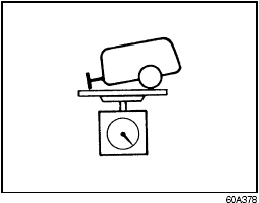
Gross Trailer Weight
Gross Trailer Weight is the weight of the trailer plus all cargo in it (measured with the trailer disconnected from the towing vehicle). Gross trailer weight must never exceed 1350 kg (3000 pounds).
If you intend to tow a trailer having a gross trailer weight greater than 450 kg (1000 pounds), the trailer must be equipped with trailer brakes.
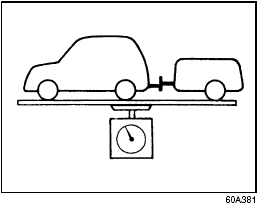
Gross Combined Weight
Gross Combined Weight is the weight of the fully loaded vehicle (including all the occupants, accessories and cargo) plus the weight of the fully loaded trailer. Gross combined weight must never exceed: • 2WD – 3400 kg (7500 pounds).
• 4WD – 3450 kg (7600 pounds).
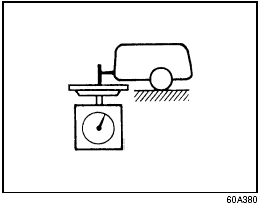
Tongue Weight
Tongue Weight is the downward force exerted on the hitch by the trailer coupler, with the trailer fully loaded and the coupler at its normal towing height. Cargo should be distributed so that tongue weight is approximately 10% of gross trailer weight.
NOTE:
You can usually get tongue weight to be
about 10% of gross trailer weight by placing
about 60% of the total cargo weight in
the front half of the trailer. You should measure
gross trailer weight and tongue weight
before towing, however, to make sure that
your load is properly distributed.
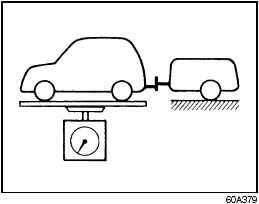
Gross Vehicle Weight
Gross Vehicle Weight is the weight of the fully loaded vehicle (including all the occupants, accessories and cargo plus the trailer tongue weight). The gross vehicle weight must never exceed the Gross Vehicle Weight Rating (GVWR) listed on the Safety Certification Label.
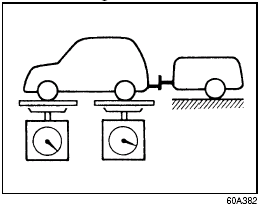
Gross Axle Weight
Gross Axle Weight (Front and Rear) is the weight supported by an individual axle with the vehicle fully loaded and the trailer connected.
Gross axle weight for the front and rear axles must never exceed the Gross Axle Weight Rating (GAWR) listed on the Safety Certification Label.
 WARNING:
WARNING:
Improper distribution of cargo in your
trailer may result in poor vehicle handling
and swaying of the trailer.
Always make sure that trailer tongue weight is about 10% of gross trailer weight. Failure to observe this requirement may result in an accident.
 WARNING:
WARNING:
Never overload your trailer or your
vehicle. Gross Trailer Weight must
never exceed 1350 kg (3000 pounds).
Gross Combined Weight must never exceed 3400 kg (7500 pounds) for 2WD or 3450 kg (7600 pounds) for 4WD.
Gross vehicle weight must never exceed the Gross Vehicle Weight Rating (GVWR) listed on the Safety Certification Label. Gross axle weight for the front and rear axles must not exceed the Gross Axle Weight Rating (GAWR) listed on the Safety Certification Label.
 WARNING:
WARNING:
Do not tow a trailer having a gross
trailer weight greater than 450 kg
(1000 pounds) unless the trailer is
equipped with trailer brakes.
Additional Trailer Towing Warnings
 WARNING:
WARNING:
Connect trailer lights and hook up
safety chains every time you tow.
 WARNING:
WARNING:
Your vehicle will handle differently
when towing a trailer. For your safety
and the safety of others, you should
observe the following precautions:
• Practice turning, stopping and
backing up before you begin towing
in traffic. Do not tow in traffic
until you are confident that you can
handle the vehicle and trailer
safely.
• Never exceed posted towing speed limits or 72 km/h (45 mph), whichever is lower.
• Never drive at a speed that causes shaking or swaying of the trailer. If you notice even the slightest sign of shaking or swaying, slow down.
• Always have someone guide you when backing.
• Allow adequate stopping distance.
Stopping distance is increased when you tow a trailer. For each 16 km/h (10 mph) of speed, allow at least one vehicle and trailer length between you and the vehicle ahead.
Follow at a greater distance if roads are wet or slippery.
• Slow down when making turns.
Remember that a larger than normal turning radius is needed because the trailer wheels will be closer than the vehicle wheels to the inside of the turn.
• Avoid sudden acceleration and stopping of the vehicle. Do not make quick maneuvers unless they are necessary.
• Slow down in cross winds and be prepared for wind blasts from large passing vehicles.
• Be careful when passing other vehicles. Be sure to allow enough room for your trailer before you change lanes, and signal well in advance.
• Slow down and shift into a lower gear before you reach long or steep downhill grades. It is hazardous to attempt downshifting while you are descending a hill.
• Avoid “riding” the brakes. “Riding” the brakes could cause the brakes to overheat, resulting in reduced braking efficiency. Use engine braking as much as possible.
• Because of the added trailer weight, your engine may overheat on hot days when going up long or steep hills. Pay attention to your engine temperature gauge. If it indicates overheating, pull off the road and stop in a safe place. Refer to the “If the Engine Overheats” in “EMERGENCY SERVICE” section for details on how to proceed.
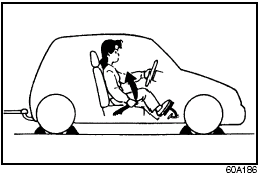
 WARNING:
WARNING:
When parking your vehicle and connected
trailer, always use the following
procedure:
1) Apply the vehicle’s brakes firmly.
2) Have another person place wheel chocks under the wheels of the vehicle and the trailer while you are holding the brakes.
3) Slowly release the brakes until the wheel chocks absorb the load.
4) Fully engage the parking brake.
5) Manual Transmission – Shift into Reverse or first gear and turn off the engine.
Automatic Transmission – Shift into Park and turn off the engine.
6) If you have a 4-wheel drive vehicle, make sure the transfer switch is not in “N” (Neutral).
When starting out after parking: 1) Push in the clutch (if equipped) and start the engine.
2) Depress the brake pedal, shift into gear, release the parking brake and slowly pull away from the chocks.
3) Stop, apply the brakes firmly and hold the brakes while you have another person remove the chocks.
See also:
Break-In
CAUTION:
The future performance and reliability
of the engine depends on the care
and restraint exercised during its
early life. It is especially important to
observe the following precautions
d ...
Speedometer/Odometer/Tripmeter/Brightness Control
Speedometer/Odometer/Tripmeter/Brightness Control
(1) Speedometer.
(2) Odometer/Tripmeter.
(3) Odometer/Tripmeter selector, Brightness control knob.
Speedometer
The speedometer indicates vehicl ...
Safety, Reliability & Pricing
In crash tests by the Insurance Institute for Highway Safety, the SX4 earned
the top rating, Good, for front and side impacts. Rear crash protection —
arguably less significant than front or sid ...
